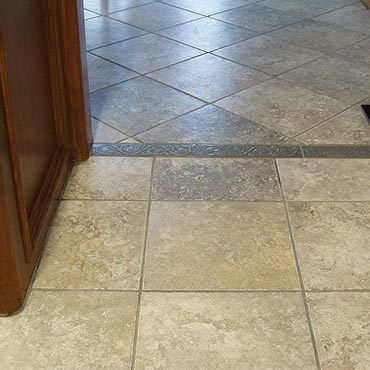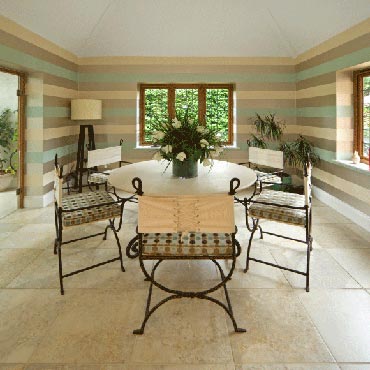Shaw captures the ancient art of ceramics in its versatile collection of ceramic and porcelain tile products. Seven of our porcelain tile collections are manufactured with the environment in mind. At Shaw Floors, we are committed to doing the right thing for the environment, and we partner with Eco-friendly suppliers who share in that commitment. Working with like-minded companies is crucial to creating a healthier ecosystem by reducing the amount of natural resources we consume. Learn More
Hard Surface Flooring
Hard Surface Flooring Guide

The Renaissance of Hard Surface Flooring: Bridging Tradition and Innovation in Modern Design
Hard surface flooring, a cornerstone in the edifice of architectural and interior design, has journeyed through centuries, evolving from mere functional elements to dynamic design statements. This transformation highlights not just a change in materials and techniques but also a shift in aesthetic sensibilities and environmental awareness.
Historically, hard surface flooring like stone and ceramics symbolized durability and artistry, gracing the halls of ancient empires and medieval castles. Today, these materials have morphed into versatile, sustainable , and technologically advanced options, seamlessly integrating into diverse architectural narratives.
Defining Hard Surface in Flooring
Hard surface flooring, in the context of tiles, encompasses materials like stone, ceramic, porcelain, and concrete. These materials are known for their durability, resistance to wear, and low maintenance, making them a practical choice for high-traffic areas.
Sustainability: A Core Consideration
Sustainability is no longer an option but a necessity in flooring choices. Eco-friendly aspects of hard surface flooring, such as energy-efficient production and recyclability, appeal to environmentally conscious architects and designers. Moreover, using locally sourced materials reduces transportation emissions, adding another layer to sustainable practices.
A Canvas for Creativity: Design Versatility
One of the most compelling aspects of hard surface flooring is its design versatility. With a plethora of colors, patterns, sizes, and finishes, these materials offer limitless possibilities for creative expression. This versatility enables designers to tailor flooring solutions to various architectural styles, from minimalist modernism to ornate traditionalism.
Technological Leap: The Future is Now
Technological advancements in manufacturing have revolutionized hard surface flooring. Digital printing on tiles, for instance, allows for high-definition, customized designs, broadening the horizon for unique and personalized spaces.
Diverse Applications: Beyond Conventional Boundaries
Hard surface flooring's application diversity is evident in its presence across various sectors. In healthcare , its antibacterial and easy-to-clean properties are invaluable, while in commercial spaces, its durability withstands high foot traffic. Residential spaces benefit from its aesthetic and functional versatility. Innovative applications, such as in outdoor settings or as decorative wall features, showcase the material's adaptability.
Performance and Functionality: More Than Meets the Eye
Beyond aesthetics, hard surface flooring excels in functionality. Its water resistance is crucial in areas prone to spills or moisture. The hygiene aspect is especially critical in healthcare and culinary settings, where cleanliness is paramount.
Eco-Friendly Flooring: The Green Revolution
Sustainable building practices increasingly incorporate hard surface flooring. The use of materials that contribute to LEED certification and other environmental standards is a testament to the industry's commitment to eco-responsibility. The production and disposal processes of these materials are now scrutinized for their environmental and health impacts, making sustainability a comprehensive criterion.
Cultural Footprints in Flooring
Hard surface flooring also carries cultural and artistic significance. In different regions, it reflects traditional designs and practices. Contemporary designers are blending these traditional elements with modern techniques, creating floors that are not just surfaces but stories.
Cost-Effectiveness: Investing in the Future
When considering long-term value, hard surface flooring stands out. Its durability and timeless appeal often outweigh initial costs, especially compared to materials requiring frequent replacement or maintenance. This cost-benefit analysis is crucial in decision-making for large-scale projects.
Concluding Thoughts: Paving the Future
In conclusion, hard surface flooring is more than a mere element of construction; it's a testament to the evolution of design thinking, blending practicality with aesthetics. Its role in sustainable building practices, combined with technological innovations, positions it as a key player in future design trends.
As architects, interior designers, and facility managers continue to sculpt our built environment, the innovative potential of hard surface flooring should be at the forefront of their considerations. Its versatility, sustainability, and aesthetic appeal make it an indispensable tool in the creation of spaces that are not only functional and beautiful but also environmentally responsible and culturally resonant.
Disclaimer: The information provided in this article is for general informational purposes only. While we strive to ensure the accuracy and reliability of the information presented, we make no warranties, express or implied, about the completeness, accuracy, reliability, suitability, or availability with respect to the content. Any reliance you place on such information is strictly at your own risk. We recommend consulting with professionals for specific advice tailored to your project’s needs, particularly regarding building codes, regulations, and product specifications.
Under no circumstances shall we be liable for any loss or damage, including without limitation, indirect or consequential loss or damage, arising from the use of, or reliance on, the information provided in this article.
Select Product Sub-Category:
Hard Surface Flooring
Top 5 Types of Hard Surface Flooring
 Ceramic/Porcelain - 405 Ceramic TileCeramic tile are clay products which are formed into thin tiles and fired. Ceramic tiles are set in beds of mortar or mastic with the joints between tiles grouted. Varieties of ceramic tiles include quarry tile, porcelain, terracotta. | Sub Categories: |
 Natural Stone Floors - 156 Natural Stone FlooringNatural stone can be cut into a variety of sizes, shapes, and thicknesses for use as flooring. Stone flooring is uses a similar installation method to ceramic tile. Slate and marble are popular types of stone flooring that requires polishing and sealing. | Sub Categories: |
 Terrazzo - 233 Terrazzo FlooringTerrazzo, can used instead of raw cut stone and are available as either preformed tiles or to be constructed in-place using a cement binder. Learn More | Sub Categories: |
 Paver/Quarry - 243 Paver/Quarry TilePavers and quarry tile are an outstanding choice for commercial and residential application that require durable, affordable flooring. Quarry tiles are naturally stain and slip-resistant, and are available with an abrasive grain for even greater traction Learn More | Sub Categories: |
 Ceramic/Porcelain - 953 Earthen FloorEarthen floors were predominant in most houses until the mid 14th century in Europe, and persist to this day in many parts of the world. Learn More |
Featured Brands
The Best 1 Hard Surface Flooring Brands

Shaw Tile Flooring
Profile | WebsiteShaw captures the ancient art of ceramics in its versatile collection of ceramic and porcelain tile products. Seven of our porcelain tile collections are manufactured with the environment in mind. At Shaw Floors, we are committed to doing the right thing for the environment, and we partner with Eco-friendly suppliers who share in that commitment. Working with like-minded companies is crucial to creating a healthier ecosystem by reducing the amount of natural resources we consume. Learn More
Hard Surface Flooring News
Latest Hard Surface Flooring News
Hard Surface Flooring...Exploring the Enduring Appeal of Hard Surface Flooring: A Comprehensive Guide for Home Decorators and Designers IntroductionIn the dynamic world of home design and decoration, Hard Surface Flooring stands as a testament to innovation, aesthetic versatility, and durability. This comprehensive guide explores its historical evolution, diverse types, aesthetic possib... |
